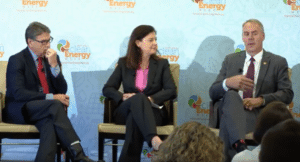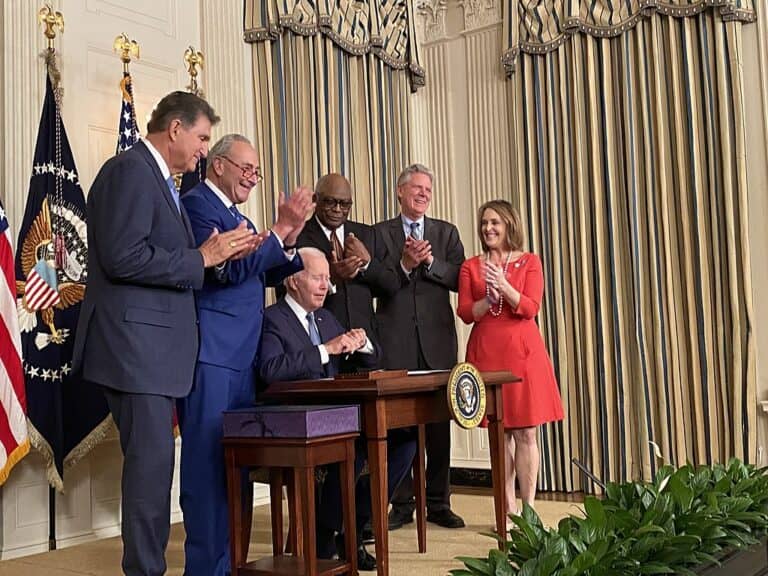Broad Interest in Nukes, Especially SMRs, at National Clean Energy Week

Keynote Panel at NCEW
National Clean Energy Week was conceived in June by the Coalition of Responsible Energy Solutions. During July and August the organizers attracted partners, sponsors and speakers. They developed a week-long agenda and located venues for the expo, symposium and panels.
Festivities began with a welcome reception for invited guests at Google’s Washington, D.C. office on Sept. 25. Tuesday’s NCEW symposium included talks by Energy Secretary Rick Perry and Interior Secretary Ryan Zinke; briefs from four members of Congress, including Sen. Lindsey Graham (R-S.C.); roundtable discussions and talks by clean energy technology leaders.
While the conference was underway, there was a technology demo fair featuring innovative products and services.
The governors of eight states—Virginia, Maine, North Carolina, Wyoming, Vermont, New Hampshire, Idaho and Nevada—issued proclamations declaring Sept. 25-29 to be National Clean Energy Week.
The organizers can perhaps be forgiven for overlooking the minor detail of attracting widespread media attention. Even energy-focused nerds – like me – could easily have been unaware that there was an opportunity to meet with like-minded, solutions-oriented people who share a number of common goals.
We encourage everyone to read our content and discuss it civilly in our moderated forum.
Amy Harder at Axios was the first writer to note the upcoming event with a post on Aug. 18. Politico, The Hill and Washington Examiner carried a few mentions the week before the event. Those mentions might have been inspired by a press release dated Sept. 21.
It’s unfortunate that an impressive organizational effort apparently resulted in good talks given to sparse audiences of people who already understand the importance of producing clean, abundant, affordable and reliable energy.
Attendance at the Symposium, described as the highlight event of the week, was estimated by attendees to be less than 200 people. That includes the presenters and panel members.
It’s fortunate, however, that the symposium was live streamed and archived. That means that the initial whispers did not disappear into the atmosphere. The messages can still be distilled, amplified and distributed.
Aside During the two weeks since I first wrote this piece, the archived live stream video of the complete symposium has been replaced by more manageable clips of individual talks and panel discussions. End Aside.
Broad Coalition Adds Value
The 13 organizations that joined the steering committee for NCEW represent a broad range of interests. They include
- Advanced Energy Economy
- American Council on Renewable Energy
- American Gas Association
- American Wind Energy Association
- Biomass Power Association
- Business Council for Sustainable Energy
- Center for Liquefied Natural Gas
- Citizens for Responsible Energy Solutions
- Clean Energy Business Network
- Energy Storage Association
- National Hydropower Association
- Nuclear Energy Institute
- Solar Energy Industries Association
It’s not surprising to note that the breadth of the steering committee offended some activist organizations. Several sent a letter to Congress criticizing the efforts of groups that advocate for biomass, fracked natural gas, liquefied natural gas, waste-to-energy, carbon capture/storage and even nuclear energy.
Groups signing that letter include some of the usual suspects who seek to limit our energy supply choices to austerity, breezes, sun beams and hot rocks.
- 350.ORG
- CENTER FOR BIOLOGICAL DIVERSITY
- DOGWOOD ALLIANCE
- ENVIRONMENTAL INTEGRITY PROJECT
- ENVIRONMENTAL WORKING GROUP
- FOOD & WATER WATCH
- FRIENDS OF THE EARTH U.S.
- GLOBAL ALLIANCE FOR INCINERATOR ALTERNATIVES
- NEW YORK PUBLIC INTEREST RESEARCH GROUP
- NUCLEAR INFORMATION AND RESOURCE SERVICE
- OIL CHANGE INTERNATIONAL
- PARTNERSHIP FOR POLICY INTEGRITY
Those groups asked federal lawmakers to limit their support to “truly clean energy, like energy efficiency and solar, wind, and geothermal Even though the purists objected, the organizers made a good decision to include a broad range of groups that are diligently seeking to improve and clean up our current energy supply system.
The event provided participants a unique opportunity to share experiences, agree on certain issues, hear from people who have both common and competing interests and attract the support of politicians whose constituents prefer “both/and” to “either/or.”
It might have surprised some of the participants to find out that Zinke believes that no one is a stronger supporter of National Parks than he is, though he admitted that many people might equal his passion and advocacy. He described himself as a Pinchot kind of conservationist and noted that Teddy Roosevelt was from the same school of thought.
During his talk, he became emotional as he described his career as a member of the Navy’s elite SEAL units, serving in 65 countries, many of which do not have reliable power. He noted that one reason he prefers domestic energy sources is that he does not want more generations of Americans to be in wars like he has fought over access to resources.
Aside: Zinke retired from the Navy as a commander (O-5) after 23 years of service. He was wearing the SEAL Trident on his lapel. I have a special affinity for retired O-5s. End Aside.
Interest in and Support for SMRs
Perry talked about his experiences as a Texas governor during a period in which his state added 7 million residents—he said that meant a lot of pickup trucks—and grew the economy while still reducing overall emissions.
He also shared a vision of a time in the near future in which it might be possible to respond to a widespread power outage–perhaps caused by a natural disaster like Hurricane Maria’s attack on Puerto Rico—by airlifting small modular reactors to supply power to thousands of people without the need to refuel.
Perry noted that his vision is currently limited by regulations, implying that public misperceptions might be the source for some of the obstructing rules.
Though only a brief portion of Perry’s talk, SMRs were highlighted by at least two other speakers. Jason Berwin, representing the Energy Storage Association, and Charles Hernick of Citizens for Responsible Energy Solutions, both seemed to have been inspired by the possibilities.
NEI’s Marc Nichol was a member of a panel on innovation, research and development.
He explained that there were about 20 companies in the U.S. developing SMRs. He noted that some use traditional water cooling technology on a smaller, more distributed scale.
He pointed out that they are being designed to be more exible, responsive and resilient with the ability to operate independently of the grid in an island mode. He also noted that there were numerous advanced non-light water reactor systems under development.
Nichol rejected the moderator’s implication that nuclear energy suffered greatly from public perception challenges, noting that national level polls show broad support. He also pointed out that the polling indicates that people who live closest to the facilities tend to be the most supportive.
Jeffrey Leahey, Deputy Executive Director of the National Hydropower Association, described a similar direction of technology advances, noting that large hydropower systems are facing some of the same retire/refurbish/relicense issues facing conventional reactors. He noted that it can take 10 years or more to obtain a license for a new facility.
He also lamented that, like nuclear, large hydro has been left out of incentive programs available to other sources of renewable, zero emission energy sources.
Two Representatives from Washington
Two members of the U.S. House of Representatives from Washington, Rep. Derek Kilmer (D) and Rep. Cathy McMorris Rogers (R), spoke about the naturally non-partisan nature of working for abundant clean energy. They each noted that environmental and economic development issues cross party lines.
Both bragged about the contributions of the Pacific Northwest National Laboratory to clean energy development, including nuclear energy, smart grid technology and advances in electricity storage.
Aside: I’d bet that both of them would be interested in learning more about the potential to restore the Fast Flux Test Facility to full operation as a cost-effective way for DOE and the National Laboratories to provide domestic access to abundant fast neutrons in support of numerous advanced reactor development projects. End Aside.
The Washington State representatives also explained the importance of hydropower to their constituents and described advances in hydropower technologies that could potentially expand the energy production from that ultra-low emission sector by a factor of two without building new dams.
Several of the speakers during the symposium expressed the hope that they were participating in the first annual National Clean Energy Week.
It is a concept worth expanding, especially if the organizers learn the importance of a well-resourced publicity campaign that uses the Internet as a supplement to more traditional – and well-proven – ways of generating media buzz.
Guerilla marketing is okay for resource-constrained start-ups, but successful organizations rapidly graduate to more extensive communications efforts.
Note: A version of the above was initially published by Fuel Cycle Week in the September 30 edition. It is republished here with permission.


I agree with Zinke when he supports domestic energy sources to avoid resource wars. This is one of the strongest reasons I have for supporting nukes.
Good report and info.
Re: “Nichol rejected the moderator’s implication that nuclear energy suffered greatly from public perception challenges, noting that national level polls show broad support.”
Let’s be honest that such polls never asks the respondent if they’d want a nuke in their vicinity, not comfortably three states away. That’s why in reality almost no one really cries for any in their own state as we’ve soberly witnessed, and of course those closest to one profit most by the jobs and taxes a local “imposed” NPP rakes in. Incomplete and misleading polls only skews public perceptions and resistance in NPP placement policy and the effort to effectively and aggressively challenge the antis without assuming there’re ready acceptance for NPPs and no real hearts and minds to win over. That’s what the nuclear community has fatally assumed for generations.
James Greenidge
Queens NY.